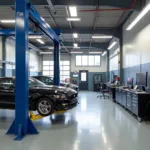Scuffed paint on your car can be an eyesore. Whether it’s a minor scrape from a parking lot mishap or a more noticeable scuff from a rogue shopping cart, knowing how to repair scuffed paint on car is essential for maintaining its appearance and value. This guide will cover everything from identifying the damage to choosing the right repair method and preventing future scuffs.
Assessing the Damage: How Deep is the Scuff?
Before you start repairing scuffed paint, it’s crucial to assess the extent of the damage. Is it a light surface scuff or a deeper scratch that has penetrated the clear coat and even the base coat? The repair method you choose will depend on the severity of the scuff. A simple cleaning might suffice for light scuffs, while deeper scratches may require touch-up paint or even professional help.
Identifying Surface Scuffs
Surface scuffs are the easiest to deal with. They typically appear as light scratches or hazy marks on the clear coat and can often be removed with a thorough cleaning and polishing. Run your fingernail across the scuff. If your nail doesn’t catch, it’s likely a surface scuff.
Recognizing Deeper Scratches
Deeper scratches penetrate the clear coat and sometimes even the base coat, exposing the primer or bare metal underneath. These scratches are more noticeable and require more extensive repair. If your fingernail catches on the scratch, it’s likely deeper than a surface scuff.
DIY Repair Methods for Scuffed Paint
Depending on the depth of the scuff, you can choose from several DIY repair methods. Remember to always work in a well-ventilated area and wear appropriate safety gear.
Cleaning and Polishing for Surface Scuffs
For light surface scuffs, a thorough wash and polish can often do the trick. Use a car wash soap specifically designed for automotive paint and a microfiber wash mitt to avoid further scratching. After washing, apply a rubbing compound or polishing compound with a microfiber applicator pad using circular motions. This can help remove light scratches and restore the shine to the clear coat.
Touch-Up Paint for Deeper Scratches
If the scuff has penetrated the clear coat, you’ll need touch-up paint. First, clean the area thoroughly. Then, apply the touch-up paint carefully, using a fine-tipped brush or touch-up pen, to fill in the scratch. Allow the paint to dry completely before applying a clear coat sealant to protect the repair.
When to Call a Professional
For very deep scratches or extensive damage, it’s best to consult a professional auto body shop. They have the expertise and tools to repair the damage properly and ensure a seamless finish.
Preventing Future Scuffs: Protecting Your Car’s Paint
Prevention is always better than cure. Here are a few tips to help protect your car’s paint from future scuffs:
- Park Carefully: Choose parking spots away from shopping carts and other potential hazards.
- Wax Regularly: Waxing your car creates a protective layer that can help prevent minor scratches.
- Use a Car Cover: If you park your car outdoors, a car cover can protect it from the elements and accidental scratches.
- Be Mindful of Obstacles: Be aware of your surroundings when driving and parking, especially in tight spaces.
“Regular waxing is crucial for protecting your car’s paint,” says John Miller, an automotive detailing expert with over 20 years of experience. “It acts as a sacrificial barrier against minor scratches and scuffs.”
Conclusion
Repairing scuffed paint on your car can be a simple DIY project or a more involved process, depending on the severity of the damage. By assessing the damage properly and choosing the right repair method, you can restore your car’s appearance and protect its value. Remember, preventing future scuffs is key, so park carefully and maintain a regular waxing schedule. By following these tips, you can keep your car looking its best for years to come.
FAQ
- Can I use toothpaste to repair scuffed paint?
- How long does touch-up paint take to dry?
- What is the best way to remove scuff marks from plastic bumpers?
- How often should I wax my car?
- Can I repair deep scratches myself?
- How much does professional car paint repair cost?
- What is the difference between a rubbing compound and a polishing compound?
“Addressing scuffs promptly prevents them from becoming larger problems,” adds Sarah Johnson, a certified auto body technician. “A small scuff left untreated can eventually lead to rust and more extensive damage.”
You might also find these articles helpful: “How to Detail Your Car Like a Pro” and “Understanding Car Paint Types and Finishes.” For further assistance, feel free to contact us via WhatsApp: +1(641)206-8880, or Email: cardiagtechworkshop@gmail.com. Our customer support team is available 24/7.


